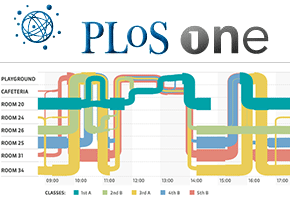High-Resolution Measurements of Face-to-Face Contact Patterns in a Primary School.
Juliette Stehlé, Nicolas Voirin, Alain Barrat, Ciro Cattuto, Lorenzo Isella, Jean-François Pinton, Marco Quaggiotto, Wouter Van den Broeck, Corinne Régis, Bruno Lina and Philippe Vanhems. PLOS ONE 6(8): e23176 (2011). doi:10.1371/journal.pone.0023176
 Background Background
Little quantitative information is available on the mixing patterns of children in school environments. Describing and understanding contacts between children at school would help quantify the transmission opportunities of respiratory infections and identify situations within schools where the risk of transmission is higher. We report on measurements carried out in a French school (6–12 years children), where we collected data on the time-resolved face-to-face proximity of children and teachers using a proximity-sensing infrastructure based on radio frequency identification devices.
Methods and Findings
Data on face-to-face interactions were collected on Thursday, October 1st and Friday, October 2nd 2009. We recorded 77,602 contact events between 242 individuals (232 children and 10 teachers). In this setting, each child has on average 323 contacts per day with 47 other children, leading to an average daily interaction time of 176 minutes. Most contacts are brief, but long contacts are also observed. Contacts occur mostly within each class, and each child spends on average three times more time in contact with classmates than with children of other classes. We describe the temporal evolution of the contact network and the trajectories followed by the children in the school, which constrain the contact patterns. We determine an exposure matrix aimed at informing mathematical models. This matrix exhibits a class and age structure which is very different from the homogeneous mixing hypothesis.
Conclusions
We report on important properties of the contact patterns between school children that are relevant for modeling the propagation of diseases and for evaluating control measures. We discuss public health implications related to the management of schools in case of epidemics and pandemics. Our results can help define a prioritization of control measures based on preventive measures, case isolation, classes and school closures, that could reduce the disruption to education during epidemics.
Data and supplementary information
See: Primary school – cumulative networks
The following movie was provided as supplementary information.
URL: http://www.plosone.org/article/info:doi/10.1371/journal.pone.0023176
PDF: http://www.plosone.org/article/fetchObjectAttachment.action?uri=info%3Adoi%2F10.1371%2Fjournal.pone.0023176&representation=PDF
BIBTEX:
@article{10.1371/journal.pone.0023176,
author = {Stehlé, Juliette and Voirin, Nicolas and Barrat, Alain and Cattuto,
Ciro and Isella, Lorenzo and Pinton, {Jean-François} and Quaggiotto, Marco
and {Van den Broeck}, Wouter and Régis, Corinne and Lina, Bruno
and Vanhems, Philippe},
journal = {PLOS ONE},
publisher = {Public Library of Science},
title = {High-Resolution Measurements of Face-to-Face Contact Patterns
in a Primary School},
year = {2011},
month = {08},
volume = {6},
url = {http://dx.doi.org/10.1371/journal.pone.0023176},
pages = {e23176},
number = {8},
doi = {10.1371/journal.pone.0023176},
keywords = {SocioPatterns}
}

|
![SocioPatterns [logo]](http://www.sociopatterns.org/wp-content/themes/sp2/images/header_logo.png)
 Background
Background